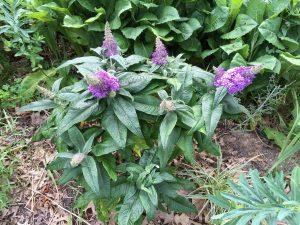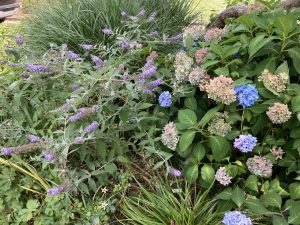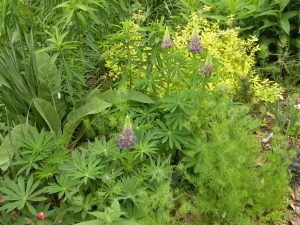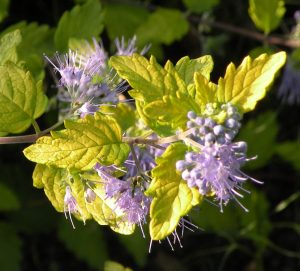The nature of a perennial garden is that is ever-changing but it always helps to have some perennials that bloom for a long period of bloom in order to plug the gaps left by those that bloom for only a short period of time. If we also avail ourselves of some flowering shrubs that, strategically placed, will not smother the perennials, we can add to the amount of color and interest in the perennial garden.

Buddleia ‘African Queen’ (to the right of the Miscanthus ‘Adagio’) is still blooming in my garden in November but is at least eight feet high.
Buddleia davidii (Butterfly Bush) is a good example. Although historically the Butterfly Bush was huge, the hybridizers have shrunk it into various sizes that are very useful. The Buzz series has selections that supposedly grow three to four feet high. It seems to me that it takes three or four years before they reach that height.

Buddleia ‘Pugster® Amethyst’ has very fat panicles.
The Pugster series selections have fatter flowers, are even shorter at two feet and can be placed at the front of a border. My Pugster Amethyst blooms nonstop from mid-July until frost and the leaves, amazingly, have stayed green during the past few winters. Happily, it is in a raised bed so I don’t have to lean over too far to deadhead it. The Chip series is also very short, not so good for people with bad backs.

Buddleia ‘Glass Slippers’ beside Hydrangea Cityline™ Paris, is also a prolific bloomer.
I’ve been really happy with Buddleia ‘Glass Slippers’, a cultivar from Walters Gardens. It is only three feet high and wide and has silvery-green foliage plus pale purple flowers. Although it only gets half a day of sun, it still blooms prolifically.
All Buddleia need full sun. They will do well in dry sites but flower better in well-drained soil and regular moisture. Unlike the larger cultivars that need to be pruned back severely each spring, the smaller ones do not unless they grow larger than you would like. Although not native, they attract a variety of bees and butterflies from July until frost and are both deer and rabbit resistant.

Although Caryopteris incana ‘Sunshine Blue’ is not in bloom yet, its foliage color makes a great backdrop for the purple lupines that bloom in my garden in late May.

Closeup of Caryopteris incana ‘Sunshine Blue’ in mid-September.
All Caryopteris should be treated as cutback shrubs. They, too, need full sun and well-drained soil and attract a variety of bees and butterflies in August and September. Happily, they also are deer and rabbit resistant.
I have only mentioned two genera that can be integrated into a perennial border for more color but there are many more of which I am sure you are acquainted.


0 Comments